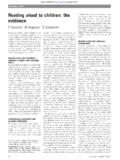Transcription of ‘Blame-the-Worker’ Behavior-Based Safety Programs
1 Behavior-Based Safety / Blame-the-Worker Safety ProgramsUnderstanding and Confronting Management s Plan for Workplace Health and SafetyUnion Training for Union MembersUnited Steelworkers Health, Safety and Environment DepartmentApril 2010 TABLE OF CONTENTS Behavior-Based Safety / Blame-the-Worker Safety Programs : Understanding and Confronting Management s Plan for Workplace Health and Safety Basic Principles of Continuous Improvement: Training Exercise Two 1 Accident Report Form Fairfield Works 3 Slide Show Handout: Welcome to Your Indoctrination in Behavioral Safety : 5 Global Trends in Health and Safety Mismanagement Why Eliminate the Hazard When You Can Buy Personal Protective 26 Equipment?
2 Multinational Monitor: Blame the Worker: The Rise of Behavioral- based 27 Safety Programs Hazards Magazine: BS Alert: Behavioural Safety Schemes -It s the Hazards, 33 Stupid Safety Incentive and Injury Discipline Policies: The Bad, the Even Worse and 35 the Downright Ugly OSHA s Recordkeeping Rule (29 CFR 1904) re: Safety Incentive and Injury 41 Discipline Policies/ Programs USW@Work (spring, 2008): Blame Game: USW Forces Employer to End 43 Injury Discipline Policy Front Lines: USW Local 105 Forces Company to End Blame-the-Worker 44 Safety Incentive Program Iowa OSHA Letter (July, 2008) re: Safety Incentive Program at Alcoa in 46 Bettendorf, Iowa House of Representatives Committee on Education and Labor, Majority 48 Staff Report: Hidden Tragedy: Underreporting of Workplace Injuries and Illnesses USW Factsheet.
3 OSHA s Voluntary Protection Program 83 iLegal Principles Concerning Mid-term Collective Bargaining and Union 85 Representation Bargaining Over Injury Discipline Policies: Submitting Information Requests 87 Information Requests Questions to Consider Re: Injury Discipline Practices 5/09 91 Sample Request to Bargain Over The Introduction of a Behavior-Based Safety 93 Program Sample Letter with Information Requests Regarding the Introduction of a 94 Behavior-Based Safety Program Behavior-Based Safety Program Information Request Questions 97 Workplace Drug Testing Employer has the Duty to Provide Information 103 for Bargaining The
4 Steelworker Perspective on Behavioral Safety : Comprehensive Safety and 120 Health vs. Behavior-Based Safety The DuPont STOP Program (11 slides) 126 Resource Handout: Why Do Workplace Injuries and Illnesses Happen? 137 Resource Handout: Controlling Hazards 142 Work Reorganization: A Hazard to Workers Health and Safety 145 Overtime and Extended Work Shifts: The Hazards to Workers Health 153 and Safety Scandinavian Journal of Work, Environment and Health.
5 Accident Risk 155 as a Function of Hours at Work and Time of 15 Things Every Union Leader Should Know About Safety and Health 161 The Role of the Union in Joint Labor-Management Health and Safety 163 Programs , Efforts and Committees: What Unions Need to Know, Understand and Be Able to Do? Resource Handout: Effective Safety and Health Committees 168 Treat It as Continuous Bargaining: Representing Members on Workplace 177 Health, Safety and Environmental Issues iiDraft Code of Conduct for Union Members Involved in Joint Labor- 180 Management Health and Safety Committee Meetings Activity Worksheet: I Chose To Look The Other Way 183 Specifically Observing Bosses Form 185 Another BBS Scam Uncovered.
6 The Truth About I Could Have Saved A 187 Life That Day Activity Worksheet: Strategy Activity for Preventing, Ending or Modifying 189 Employers Blame-the-Worker Behavior-Based Safety Programs iii BASIC PRINCIPLES OF CONTINUOUS IMPROVEMENT TRAINING EXERCISE TWO Comparing the Use of Hands Comparing what each hand is doing while performing work is a very useful tool not only for recognizing non-value work but also for uncovering possible causes of repetitive motion damage and fatigue. It is a very easy exercise to do. Simply by comparing what each hand is doing while performing work provides an effective road map for Continuous Improvement activity.
7 Consider the example of a technician who is sub-assembling a washer and a nut to a stud. Two such sub-assemblies are required for each vehicle built. A comparison of the technician s hand movements as he works at his sub-assembly table shows the following results: Left Hand Right Hand (1) Pick up stud from tray (2) Transfer stud to left hand (3) Grasp and hold stud Release stud (4) Pick up washer from tray (5) Position washer over stud (6) Pick up nut from tray (7) Loose assemble nut to stud (8) Hand start nut to proper position (9) Release stud Dispose of nut and stud Although the work being performed in the example is easy work, the principles shown are very clear.
8 Examination of the comparison shows that only the right hand and arm are actively working. The right arm and hand bear the full force of any fatigue associated with the sub-assembly. A closer examination also shows that the left hand is doing non-value work only. Recognizing and identifying this non-value work is the beginning of Continuous Improvement activity which will create the smooth process flow. 1(The continuous improvement involves installing an inexpensive holding fixture and adapting an air tool.) IMPROVED SITUATION Left Hand Right Hand (1) Pick up nut from tray Pick up nut from tray (2) Place nut in holding fixture Place nut in holding fixture (3) Obtain washer Obtain washer (4) Place washer on nut Place washer on nut (5) Obtain stud Obtain stud (6) Hand start stud to nut Hand start stud to nut (7) Grasp air tool Grasp air tool (8) Position tool and pre-secure stud to nut Position tool and pre-secure stud to nut (9) Release air tool Release air tool (10)
9 Dispose of nut and stud Dispose of nut and stud Accumulated Results Capacity has been increased (2 built instead of 1) Non-value work has been minimized Work load impact is spread across more body muscles instead of being isolated to only the right arm and hand Variability of the quality of the stud and nut sub-assembly has been eliminated Variability within Jim s operation has been greatly reduced because the stud and nut sub-assemblies he must use are of a consistent and constant quality The work flow is smoother because more variability has been eliminated The technician decided the benefits as a result of his proposal were good, so he moved forward with his proposal.
10 MANY IMPROVEMENTS CAN OCCUR FROM ELIMINATING NON-VALUE WORK 234 Behavior-Based Safety1 With crippled limbs and mangled feet, a million man-hours we did meet;With records kept such as these,'ll h illi it'll b bwe'll reach a zillion it'll be a breeze;Rewards are for achievements met,but we ain't reached a million yet;Their Safety program is a shamTheir Safety program is a sham,As for you and me? They don't give a workerChemical processing plantWelcome to your indoctrination in BS:Global Trends in Health and Safety Mismanagement5 Behavior-Based Safety2 The fact is, it is not easy for an individual to have a serious injury in today s workplace.






